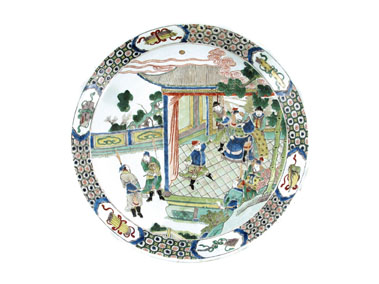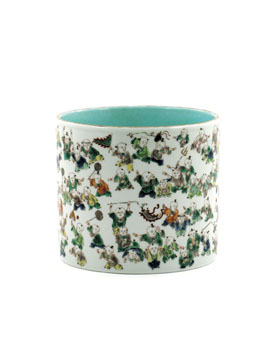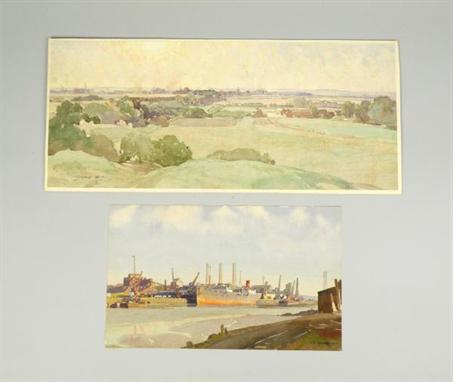A Chinese famille verte dish, with a channelled footrim, decorated with a central panel depicting three women making music in a fenced garden, around the cavetto are eight shaped panels illustrating episodes from the Xiyou Ji (The Journey to the West), the reverse with three flower sprays and with an artemesia leaf mark, Kangxi 1662-1722, broken and repaired, 35cm. From the collection of Professor D R Laurence MD. Provenance: purchased from S. Marchant & Son, London. Cf. C J A Jorg, Chinese Ceramics in the Collection of the Rijksmuseum, Amsterdam, no. 165 for an almost identical dish.
We found 297893 price guide item(s) matching your search
There are 297893 lots that match your search criteria. Subscribe now to get instant access to the full price guide service.
Click here to subscribe- List
- Grid
-
297893 item(s)/page
A large Chinese famille verte dish, decorated with a dignitary seated in a pavillion with two attendants and four warriors, the rim with panels of antiques on a diaper ground, the base with a shop mark, Kangxi 1662-1722, extensively damaged and restored, 38.2cm. From the collection of Professor D R Laurence MD. Provenance: purchased from D & M Freedman, London.
A Chinese famille verte moulded dish, painted with a dignitary seated on a terrace with attendants before a screen, the cavetto with landscape panels of a spotted green ground, an artemesia leaf mark, Kangxi 1662-1722, broken in half and repaired with rivets, 27.5cm. From the collection of Professor D R Laurence MD. Provenance: purchased from D & M Freedman, London. Previously in the collection of Agatha Christie - purchased at the sale of contents of her holiday home Greenway, Devon, 12th September 2006.
A large Chinese famille verte dish, decorated with a scene from a romance, depicting nine beautiful young ladies, an artemesia leaf mark, Kangxi 1662-1722, extensively damaged and restored, 37cm. From the collection of Professor D R Laurence MD. Provenance: purchased from R & G McPherson Antiques, London.
A large Chinese Swatow-type stoneware dish, painted in underglaze blue with a panel of scrolling flowers and with floral sprays to the cavetto, Fujian province late 16th/early 17th century, old restored rim chips, 41cm. From the collection of Professor D R Laurence MD. Provenance: purchased from R & G McPherson Antiques, London. Cf. Soame Jenyns, Ming Pottery and Porcelain, pl.119b for a related dish in the V&A Museum, London.
A Chinese blue and white potiche and cover, on a high curved foot, painted with two panels enclosing a landscape scene, Kangxi 1662-1722, damages, 16cm. (2) From the collection of Professor D R Laurence MD. Provenance: purchased from D & M Freedman, London. Cf. C J A Jorg, Chinese Ceramics in the Collection of the Rijksmuseum, Amsterdam, No. 108 for a similar example decorated with antiques.
A Chinese blue and white large saucer dish, with a channel footrim, painted with two scaly four-clawed dragons contesting a flaming pearl, all reversed in white on a blue wash ground, the reverse with Buddhist emblems, an artemesia leaf mark, Kangxi 1662-1722, rim chips, 34cm dia. From the collection of Professor D R Laurence MD. Provenance: purchased from S. Marchant & Son, London.
A Chinese blue and white moulded dish, painted in the Kraak style with a central roundel enclosing a scene depicting a scholar and his attendant, the cavetto with twelve panels of landscape scenes, Tianqi period (1622-1627), minor faults, 27cm. From the collection of Professor D R Laurence MD. Provenance: purchased from D & M Freedman, London.
A Chinese porcelain vase, originally of archaic gu shape, with upper rounded section and tall foot gently spreading towards the base, decorated in underglaze blue with elaborate floral scrolls against a red over-glaze enamel ground, the protruding flanges with wave patterns, Wanli 1573-1620, the neck reduced, 19.5cm. From the collection of Professor D R Laurence MD. Provenance; purchased from JAN Fine Art, London. Cf. A similar complete vase is shown in the Illustrated Catalogue of Ming and Ming-style Polychrome Wares in the Percival David Foundation of Chinese Art, p.31, no.44.
A large Chinese cylindrical brush pot, decorated to the exterior in famille verte enamels with the Hundred Boys, early 20th century, 18.3cm dia. From the collection of Professor D R Laurence MD. Provenance: purchased from Admiral Vernon Antiques Market, London. The Hundred Boys represent the Chinese desire for many sons to carry on the family name and bring honour to the family. There are many traditions associated with achieving this wish such as offering young brides candied lotus seeds at the New Year celebrations, and adding an arrowroot bulb (which resembles a baby boy`s penis) into the New Year`s cooking.
A Chinese rectangular porcelain plaque, painted by Yu Hanqing (1902-1987) in enamels with a scene showing a mountainous landscape, a pavillion by a river, and with two figures looking towards a fisherman and his boat, and with eleven lines of calligraphy including the date for the Summer of Jiashen (1944), 39 x 25cm. From the collection of Professor D R Laurence MD. The inscription reads: `A trace of the dawn stirs the riverbank, the green of the willows and the mist gradually becomes distinct, Beside the West Bank (?) another boat has appeared, and gentlemen at their leisure are seen as though in a picture`. Cf. Brush and Clay, pls.117-118 for a covered box and rectangular tile by the artist, Innovation and Ceramics, Jingdezhen Ceramic Museum 2004, no.94 for a brush washer in a different style.
A Chinese blue and white meiping vase, with a short narrow neck and flared rim, painted with a band of lotus scroll around the body, a border of rocks and cresting waves around the foot, and a band of peonies within gadroon panels at the shoulder, Ming dynasty 1st half 16th century, glaze defect to the shoulder, glaze degradation probably due to sea immersion, 25cm. From the collection of Professor D R Laurence MD. Provenance: purchased from R & G McPherson, London.
A large Chinese blue and white cylindrical brush pot, with straight sides slightly flared towards the mouth, delicately painted in underglaze blue with a scene from a romance, late Ming dynasty, c.1630-40, extensive damage and restoration, 21.8cm. From the collection of Professor D R Laurence MD. Provenance: purchased from R G McPherson Antiques. Cf. Chinese Porcelains of the 17th century: Landscapes, Scholars` Motifs and Narratives, no.61 for a similar example.
A large Chinese blue and white bowl, the exterior painted with the Eight Treasures surrounded by scrolling foliage and lotus flowerheads beneath a key-fret border and above lappets, the interior with a similarly decorated panel, the base with a six character Jiajing mark and of the period 1522-1566, extensive cracks, 33cm. From the collection of Professor D R Laurence MD. Provenance: purchased from S. Marchant & Son, London. Cf. 16th Century Ming Treasures from Taipei, published in Japan, copyright Gakken, 1978, pl.10 for a similar example.
A Chinese dish, painted in underglaze blue, wucai enamels and gilt with a kylin beside bamboo, prunus, flowers and rockwork, beneath a flying phoenix, the cavetto with a leaf scroll border, the base with a rare pentafoil medallion containing a phoenix and cloud scrolls, Kangxi 1662-1722, old restoration to the rim, 30.7cm. From the collection of Professor D R Laurence MD. Provenance: purchased from JAN Fine Art, London. Cf. J Ayers, The Koger Collection, pl.110 for a similar example.
A Chinese blue and white yen yen vase, brightly painted in underglaze blue with a dignitary and his servant being approached by a peasant with a gift, and a water buffalo in the foreground, the neck with sages inspecting a scroll, Kangxi 1662-1722, some damages, 46cm. From the collection of Professor D R Laurence MD. Provenance: purchased from D & M Freedman, London. Cf. A similar vase from the collection of Avery Brundage is illustrated in Chinese Ceramics, The Standard Guide, no. 589.
A Chinese blue and white sleeve vase, finely painted around the body with a scene depicting a warrior bearing a spear and with two attendants, consulting a sage who holds a gnarled staff and points to the mountains, the central band with four cranes divided by scrolls, all between anhua bands of flowers and chevrons, Shunzhi period 1644-1661, restoration to base, 43cm. From the collection of Professor D R Laurence MD. Cf. Shunzhi Porcelain, Treasures from an Unknown Reign, no.55 for a similar vase.
An ivory seated figure of Buddha, holding an alms bowl in his left hand and raised on a double lotus throne, 18th century or earlier, wood stand, 11.9cm excluding stand. (2) Paper label for Louis Joseph. Provenance: collection of Professor R C Cookson, (1922-2008). Cf. The International Exhibition of Chinese Art, The Royal Academy of Arts, London 1935/6, catalogue no.2925 for a related figure.
A Chinese jadeite carving of a young woman, standing wearing long flowing robes, and holding a pipe in both hands, beside her a fruiting peach branch rises from pierced rockwork, 18th/19th century, 21.5cm, raised on a pierced hardwood stand. Provenance: collection of Professor R C Cookson, (1922-2008). Purchased from Louis Joseph, London, for £120, 13th October 1959. Cf. J. Hartman, Chinese Jade of Five Centuries, pl.49 for a related figure in the University Museum of Pennsylvania.
A rare set of five Chinese ivory armour-clad figures of warriors, comprising: Guandi accompanied by two of his generals and two attendants, each carrying halberds and dressed in chain mail with elaborate mask pendants, mid 19th century, 26cm. (5) Provenance: collection of Professor R C Cookson, (1922-2008), purchased from Louis Joseph, Knightsbridge London, April 12th 1958 for £270. Cf. Phillips International Auctioneers and Valuers, Sir Victor Sassoon Chinese Ivory Trust, 9th-20th November 1999, no.32 for a comparable example.
A Chinese celadon jade vase, rising from the back of a seated phoenix, the vase carved with a band of stylized fungus and with a bifid kylin dragon to the reverse, all crisply carved and well defined, 18th century, raised on a reticulated wood stand, 11cm. (2) Provenance: collection of Professor R C Cookson, (1922-2008).
A massive pair of Chinese fahua pottery models of Buddhistic lion dogs, each beast well modelled with lively expressions, seated on their haunches, adorned with bells, the male with his right paw on a brocade ball, while the female holds her puppy, both raised on elaborate rectangular plinths and glazed in dark aubergine and turquoise with pale yellow and white details, Ming dynasty 16th/17th century, minor restoration, 47cm. (2) Provenance: Christie`s London, 6th December 1993, lot 79. Cf. Maria Antonia Pinto de Matos, Porcelana Chinesa, Museu Calouste Gulbenkian, No.39 for a related example of the same size, and R. Krahl, Chinese Ceramics: The Anthony de Rothschild Collection 2, no.240.
A Chinese biscuit porcelain ewer, modelled as a crouching hen with two chicks at her feet, decorated with green, yellow and aubergine enamels, 18th century, chips to the comb, beak and wattle, the cover lacking, 15cm. Cf. R. Krahl, Chinese Ceramics: The Anthony de Rothschild Collection 2, no.230 for a similar example.
A pair of Chinese famille verte plates, each decorated with the Eight Horses of Mu Wang in a landscape, the borders with rock work and prunus, each with a ding mark, Kangxi 1662-1722, 22cm. (2) Provenance: collection of Professor R C Cookson, (1922-2008). One with a paper label, M.Meyer Collection. no.125.
A Korean celadon wine cup, the fluted sides inlaid in slip with flower heads, the associated stand incised with further floral sprigs, Koryo, 12th century, the bowl extensively restored, the stand with a small rim chip, 14.5cm. (2) Provenance: collection of Professor R C Cookson, (1922-2008).
A group of five family medals comprising World War I war medal and Victory medal awarded to `24738 PTE R RAY KSLI` mounted on bar with ribbons, and a World War II trio comprising 1939 - 45 war medal, 1939 - 45 Star and the France and Germany Star in cardboard box of issue `MR VM RAY`, also a World War I Victory medal awarded to `315126 PTE WW Davies Monmouth R` and three badges (9)
A 1908 pattern Cavalry sword, with sheet steel bowl guard and pommel, chequered grip with thumb depression, single fullered flat back tapering blade by Mole, steel scabbard with two fixed loops, stamped `R R H G` for Royal Horse Guards, and `S B & N`, blade 88cm long, overall length including scabbard 110.5cm
The Folio Society - Thomas, Dylan, `Under Milk Wood`, published by The Folio Society, London 1972, illustrated by Ceri Richard, decorated green cloth boards, in slip case, 4to, also thirty three other Folio Society volumes including works by R L Stevenson, Siegfried Sassoon, Catherine Mansfield and others, the majority in slip cases (33)
Evans, Thomas, `Old ballads, historical and narrative`, published by R H Evans, London, 1810, leather boards, 4to, also two companions, Shenstone, William, `The works in verse and prose`, published by J Dodsley, London 1773, three volumes, also a quantity of other leather bound volumes including `The works of Pope, Homer, Dibdin and others` (approximately 40)
A small silver cased key wound half hunter pocket watch with engine turned decoration, blue enamel Roman numerals to the case and the plain white enamel dial with Roman numerals and separate seconds dial (working order) and a gentleman`s silver cased key wound pocket watch, the plain case with engraved cartouches to front and back and the plain white dial with Roman and Arabic numerals and separate seconds hands marked W R Thompson, Liverpool (as viewed, front glass missing).
Dr John Murray (1809-1898). The gateway to the Taj Mahal from the southern wall, ca.1858. Albumen print with waxed paper negative. Watermark reads ‘R. Turner Patent Talbotype’, numbered in ink 17/3 in the negative on the verso. Print: 38 x 47 cm. (15 x 18 1/2 in.). Negative: 37 x 46.5 cm. (14 1/2 x 18 1/4 in.)
-
297893 item(s)/page


























































